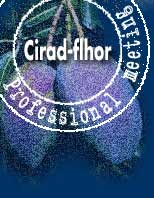

New litchi conservation techniques
Marie-Noëlle Ducamp-Collin, Cirad-flhor
France is the leading destination and consumer country for litchi with nearly 80% of the total for Europe. Madagascar is the leading world exporter with 16 000 tonnes, mainly exported by sea except at the beginning of the season when the fruits travel by air. Air freight is used for high quality fresh litchi (treated or untreated) from other origins (Réunion, Mauritius, etc.).
The poor keeping qualities of litchi handicap the development of exports. At ambient temperature, litchi loses its pink-red colour and browns very rapidly. This enzymatic browning is shown by cell disorganisation. The drying of the area close to the peduncle causes cracking resulting in cell degradation and the coming into contact of polyphenoloxydase (PPO) and phenolic compounds. Browning may also be related to non-enzymatic phenomena (Maillard reaction) enhanced by bacterial attacks or lesions caused by insects, heat, physiological stress and the presence of ethylene.
The control methods that can be envisaged are the maintaining of the moisture content of the fruit shell, the blocking of the enzymatic systems responsible for browning (by using an inhibitor) and the limiting of fungal and bacterial attacks. The method most widely used is the fumigation of fruits using sulphur dioxide (either SO2 in gas form or produced by burning sulphur) a few hours after harvesting, prior to sea transport. SO2 treatment of litchi is sometimes followed by soaking in an acid bath to restore the red colour of the fruits after the bleaching caused by sulphur treatment; this results in commercially attractive fruits. However, it should not be forgotten that the use of SO2 is a risk to health, especially for people suffering from allergies. Today, SO2 treatments have totally ceased in the United States, except for treating table grapes. French legislation authorises residue levels of 10 ppm in litchi pulp and 250 ppm in shells. Alternatives to sulphur have been examined by various research teams, in particular in Israel and South Africa. The treatments proposed are based on various chemical or heat techniques:
- application of calcium nitrate to increase cell wall strength; this has does not significantly slow pericarp browning;
- steam treatment;
- soaking in hot benomyl.
None of these investigations has yet led to the devising of a treatment method that is acceptable or developed commercially.
As the trend is for the precautionary principle, it is very probable that these levels will be lowered or even that the use of SO2 will no longer be permitted. In this context, it is particularly important to provide sector trade operators with a technique to replace fumigation. This is why we addressed the development of a conservation technique that would maintain litchi colour.
Litchi shipped by air
The creation of a modified atmosphere (MA) requires the use of a packaging film with the following purposes:
- creation of a packing volume of MA favourable for product conservation;
- limiting dehydration;
- preventing contamination;
- defining the sales unit;
- forming a support for communication.
- prevention of fruit browning;
- reduction of mould growth;
- prevention of fermentation;
- ensuring that the produce is free of sulphur derivatives that are harmful for health.
The system functions as follows: plant respiration releases CO2 into the dead space of the packaging and uses the oxygen in this volume. This modification of the atmosphere creates a difference in partial pressure between the inside and the outside of the system. This causes gas diffusion phenomena between the inside and outside of the packaging. Atmospheric oxygen tends to enter and CO2 tends to be released. This is a dynamic system that can stabilise at a recommended gas balance.
This balance depends in particular on:
- the respiratory intensity of the produce, the quantity packaged and the storage temperature;
- the film permeability and the exchange surface. Mastery of an MA involves the control of these parameters.
Litchi shipped by sea
We then addressed the development of treatments making it possible to avoid using sulphur. In the light of the literature and the research performed at the CIRAD-FLHOR technology laboratory, our research was directed towards treatments consisting of soaking the fruits in hot or cold acid baths. Our first conclusions led us to favouring a cold treatment that would have the advantage of reducing handling risks if it were used at production. Finalisation of the trials is in progress because they must be transposed to real conditions. The tests show that the soaking and the procedure that we have developed maintain the red colour of the fruits without causing negative secondary effects and results in less marked drying of the fruits treated. We are now studying the mechanism involved during this blocking of fruit colour. The tests are being continued until the coming litchi season (2001/2002) and will be the subject of a publication.
Conclusion
We have acquired substantial knowledge of the physiology and metabolism of litchi. The limits of the atmosphere that enables the length of the life of fruits have been determined. A phase of transposition and validation of the techniques that we wish to develop is to be started for both 'air' and 'sea' litchi.
|
Centre de coopération internationale en
recherche agronomique pour le développement |